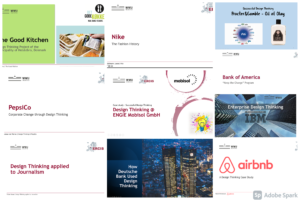From 9am to 12pm Eastern time on May 12th, 2021, students of varying institutions took Design Thinking training. SAP’s Design Thinking training was held by Kerry Brown and accompanied by Julie Bartholic and Mark McCauley and other faculty. Sequentially, the participants all introduced themselves, listened to how SAP interprets Design Thinking, separated into groups, worked through the stages of the process, and then did a small workshop reflection called “I Like, I Wish, I Wonder” of likes, dislikes, and future inquiries.
The training was really transformational in how I, as well as others, viewed Design Thinking. Working through the phases in teams with additional guidance helped me digest how to yield results in the unconventional, unique way DT is able to. By truly trying to understand the consumers, you are able to eventually think how they think. The Crazy 4 exercise surprised me the most. Delegating time to brainstorm constructive ideas with no limits to a box and no reservations as to where your imagination can take you fully instills a creative space. Drawing pictures also surprised me with how much the pictures aid my ideas, articulate details, and generate new thoughts. Talking to my peers after the training, they agreed with these points, and actually thought the training could have been longer. The event was interactive, intriguing, and inviting; I myself did not want the meeting to end.
By doing the “I Like, I Wish, I Wonder” activity, it provided a great deal of intel from the students to what they liked and what could be improved. In a way, it was like crowdsourcing because students in this training are users/consumers. A general consensus liked the interactivity, wanted the training to be in person, and wished to more training methods were similar to this one. There were so many takeaways outside of just learning Design Thinking. The training promoted intuition, elaboration, perspective, communication, and originality. As being an out-of-the-box thinker myself, this event was so important to me because it showcases how to make something out of these arbitrary thoughts. It connects people’s thoughts together, and molds it into a functional product. I think Design Thinking can be used for predictive research, strategic planning, and forecasting. I absolutely love how Design Thinking is so much more different than other methodologies because it’s not uniform. There is no systematic way of accomplishing a project through DT, and the methodology is not replicable with its predecessors. In my opinion, it sets itself apart from software programs because it relies on empathy. Human emotion is what technology lacks, and is the only thing that prevents technology from taking over everything.
-Jessica Kafati



